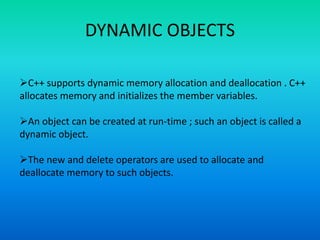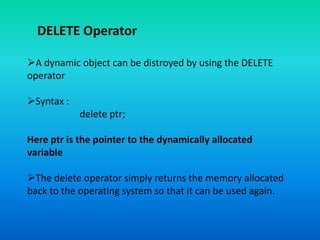Dynamic Objects,Pointer to function,Array & Pointer,Character String Processing
- 1. ‘ Dynamic objects, pointer to function, array and pointers, character string processing ’ Presented By: Muskaan (MCA/25020/18) Prashi Jain (MCA/25022/18)
- 2. DYNAMIC OBJECTS C++ supports dynamic memory allocation and deallocation . C++ allocates memory and initializes the member variables. An object can be created at run-time ; such an object is called a dynamic object. The new and delete operators are used to allocate and deallocate memory to such objects.
- 3. NEW Operator The new operator is used to allocate memory at runtime. The memory is allocated in bytes. Syntax: DATA TYPE *ptr = new DATA TYPE; // Pointer initialized with NULL // Then request memory for the variable int *p = NULL; p = new int; OR // Combine declaration of pointer // and their assignment int *p = new int;
- 4. We can initialize a variable while dynamical allocation in the following way: int *ptr = new int (4); Example: #include<iostream.h> #include<conio.h> int main() { int *ptr = new int; *ptr = 4; cout << *ptr << endl ; return 0; } OUTPUT: 4
- 5. DELETE Operator A dynamic object can be distroyed by using the DELETE operator Syntax : delete ptr; Here ptr is the pointer to the dynamically allocated variable The delete operator simply returns the memory allocated back to the operating system so that it can be used again.
- 6. Let’s look at an example: int main() { int *ptr = new int; *ptr = 4; cout << *ptr << endl; delete ptr; return 0; } OUTPUT: 4
- 7. ADVANTAGES: The main advantage of using dynamic memory allocation is preventing the wastage of memory. We can allocate (create) additional storage whenever we need them. We can de-allocate (free/delete) dynamic space whenever we are done with them
- 8. POINTER TO FUNCTION C++ allows you to pass a pointer to a function. Simply declare the function parameter as a pointer type. Syntax: data type fun_name(data type *arg)
- 9. Let’s look at an example: #include <iostream.h> void swap( int *a, int *b ) { int t; t = *a; *a = *b; *b = t; } int main() { int num1, num2; cout << "Enter first number" << endl; cin >> num1; cout << "Enter second number" << endl; cin >> num2; swap( &num1, &num2); cout << "First number = " << num1 << endl; cout << "Second number = " << num2 << endl; return 0; }
- 10. OUTPUT: Enter first number 2 Enter second number 4 First number = 4 Second number = 2
- 12. Array An array is collection of items stored at continues memory locations. Syntax : Int arr[10]; //Array declaration by specifying size
- 13. Pointers A pointer is a variable whose value is the address of another variable. Like any variable or constant. Syntax : type * var_name; //declaration of an pointer Example: int *p,a; p=&a;
- 14. Arrays and pointers Arrays and pointers are very closely related in c++. For Example: An array declared as Int a[10] Can also be accessed using its pointers representation . The name of the array is a constant pointer to the first element of the array. So a can be considered as const int*. Here arr points to the first element of the array
- 15. For example: In array and pointers ptr[i] and*(ptr+i) are considered as same. Int a[4]={10,20,30,40}; Int *ptr = a; for(int i =0 ; i<4; i++) { cout<< *(ptr+i) <<endl; } Output: 10 20 30 40
- 16. For the same array For(int i=0 ; i<4;i++) { Cout<< ptr[i] <<endl; } Output: 10 20 30 40
- 17. Character string processing String: In C++, the one-dimensional array of characters are called strings, which is terminated by a null character 0. Syntax: char greeting[6];
- 18. What is character string processing? Character string processing basically means accessing (insertion and extraction operators) the characters from a string. C++ provides following two types of string representations − • The C-style character string. • The string class type introduced with Standard C++.
- 19. Insertion operator : The result of inserting a char pointer to an output stream is same as displaying a char array whose first element is located at the address to which the char* object points. Example: Char text[9]= “world”; For(char *ptr = text; *ptr!= ‘0’ ; ++ptr) { Cout<< ptr << endl; } Output : world orld rld ld d
- 20. Extraction operator When the right operand of an extraction operator is a char* object, the behaves same as extraction from char array- by default leading white space is skipped and the next nonwhitespace string of characters is extracted. For example: char str[40]; Cout<<“enter a string:” ; Cin>> str; Cout<<“you entered :” <<str <<endl; } Output : enter a string : programming is fun you entered: programming
- 21. String functions 1- strlen(): returns the length of the sytring. Syntax: int strlen(s1); 2- strcpy(): copies one string to another string. Syntax: char *strcpy(s1 , s2); 3- strcat(): this function concates two strings. syntax: char *strcat(s1 , s2 ); 4- strcmp(): compares two strings. syntax: strcmp(s1 ,s2);
- 22. THANK YOU











![Array
An array is collection of items stored at
continues memory locations.
Syntax : Int arr[10]; //Array declaration by
specifying size](https://image.slidesharecdn.com/22prashi20mukaan-200407183228/85/Dynamic-Objects-Pointer-to-function-Array-Pointer-Character-String-Processing-12-320.jpg)

![Arrays and pointers
Arrays and pointers are very closely related in c++.
For Example: An array declared as
Int a[10]
Can also be accessed using its pointers representation . The
name of the array is a constant pointer to the first element of the
array. So a can be considered as const int*.
Here arr points to the
first element of the array](https://image.slidesharecdn.com/22prashi20mukaan-200407183228/85/Dynamic-Objects-Pointer-to-function-Array-Pointer-Character-String-Processing-14-320.jpg)
![For example:
In array and pointers ptr[i] and*(ptr+i) are considered as same.
Int a[4]={10,20,30,40};
Int *ptr = a;
for(int i =0 ; i<4; i++)
{
cout<< *(ptr+i) <<endl;
}
Output: 10
20
30
40](https://image.slidesharecdn.com/22prashi20mukaan-200407183228/85/Dynamic-Objects-Pointer-to-function-Array-Pointer-Character-String-Processing-15-320.jpg)
![For the same array
For(int i=0 ; i<4;i++)
{
Cout<< ptr[i] <<endl;
}
Output:
10
20
30
40](https://image.slidesharecdn.com/22prashi20mukaan-200407183228/85/Dynamic-Objects-Pointer-to-function-Array-Pointer-Character-String-Processing-16-320.jpg)
![Character string processing
String:
In C++, the one-dimensional array of characters
are called strings, which is terminated by a null
character 0.
Syntax: char greeting[6];](https://image.slidesharecdn.com/22prashi20mukaan-200407183228/85/Dynamic-Objects-Pointer-to-function-Array-Pointer-Character-String-Processing-17-320.jpg)

![Insertion operator : The result of inserting a char pointer to
an output stream is same as displaying a char array whose
first element is located at the address to which the char*
object points.
Example: Char text[9]= “world”;
For(char *ptr = text; *ptr!= ‘0’ ; ++ptr)
{ Cout<< ptr << endl;
}
Output : world
orld
rld
ld
d](https://image.slidesharecdn.com/22prashi20mukaan-200407183228/85/Dynamic-Objects-Pointer-to-function-Array-Pointer-Character-String-Processing-19-320.jpg)
![Extraction operator
When the right operand of an extraction operator is a char*
object, the behaves same as extraction from char array- by
default leading white space is skipped and the next
nonwhitespace string of characters is extracted.
For example: char str[40];
Cout<<“enter a string:” ;
Cin>> str;
Cout<<“you entered :” <<str <<endl;
}
Output : enter a string : programming is fun
you entered: programming](https://image.slidesharecdn.com/22prashi20mukaan-200407183228/85/Dynamic-Objects-Pointer-to-function-Array-Pointer-Character-String-Processing-20-320.jpg)

